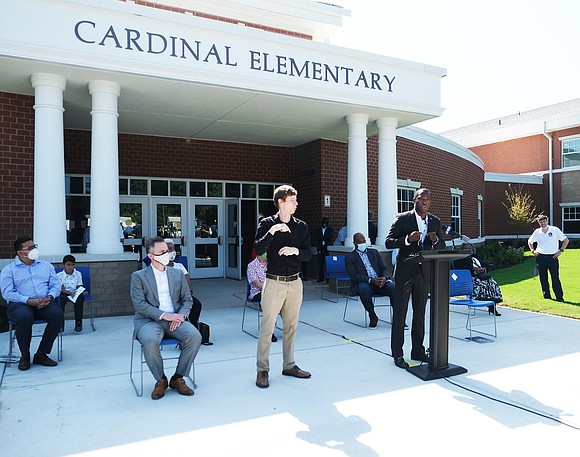Construction of new city schools didn’t meet deadline, goal for minority participation
Jeremy M. Lazarus | 10/29/2020, 6 p.m.
Richmond has built three new school buildings, but can teachers and students use them if the School Board decides to restart in-person learning?
Yes, for Henry L. Marsh III and Cardinal elementary schools, which just gained the required temporary occupancy permits allowing them to be used, but no for the new River City Middle School, which has not yet passed inspection.
None of the occupancy permits had been granted nearly eight weeks ago when Mayor Levar M. Stoney held a news conference on Sept. 3 to ceremoniously turn over the keys to the three new school buildings to Richmond Schools Superin- tendent Jason Kamras.
City Hall officials confirmed this week that work on all three buildings was still being finished at the time.
The delayed finish, though, appears to vindicate critics who warned two years ago that the construction method the city employed might not produce the best results and likely would raise costs.
At this point, the three construction projects have not met the mayor’s stated goal of having at least 40 percent of the site and construction work done by Black- and minority-owned businesses subcontractors.
And state data suggests the collective construction cost for the three buildings has run at least $16 million above the average other Virginia jurisdictions paid for school building construction during the same period.
Most evident is the missed deadline for having the buildings ready for use. Under the signed contracts issued by the city, the construction of all three buildings was to be completed Aug. 17 so each building could be furnished and computer systems set up before classes began Sept. 8.
In a statement the city’s Capital Projects team issued through the city press secretary’s office, the team, which did not identify its members, stated that the rush to complete the buildings eased after the School Board voted July 14 to keep buildings closed during the start of the 2020-21 academic year and have students take online classes because of the pandemic.
According to the statement, the “physical construction of the three new schools was sufficiently complete, that had it not been for the RPS decision to utilize virtual learning due to the ongoing COVID-19 epidemic, the three schools would have been ready and available” for the start of classes.
That would have required at least a temporary certificate of occupancy.
City Hall on Wednesday provided copies of the temporary occupancy certificates for Cardinal and Marsh elementary schools. The temporary certificate for Cardinal Elementary, 1745 Catalina Drive, built by S.B. Ballard Construction Co. to replace E.S.H. Greene Elementary, was issued Oct. 23, one day after city records show the building failed a final inspection.
The certificate for Marsh Elementary, 813 N. 28th St., which was built to replace George Mason Elementary and constructed by Branch Builds Inc., was issued on Tuesday.
The Capital Projects team stated that River City Middle, 6300
Hull Street Road, built by Howard Shockey & Sons Inc., is “undergoing special inspections, and we are monitoring its progress toward” securing a temporary certificate of occupancy.
City records show River City Middle failed its latest final inspection Tuesday.
Two years ago, the Virginia Contractor Procurement Alliance warned Mayor Stoney and then-City Council President Chris A. Hilbert that the city would regret hiring contractors through a non-competitive process rather than using the traditional method of seeking sealed bids and awarding the contract to the qualified bidder who offered the lowest price. Mayor Stoney responded that the city would move forward without sealed bids.
Reports issued to Richmond Public Schools show the three schools cost a total of $146 million, including construction.
Matthew Benka, a spokesman for the contractor alliance, said that state data on school construction costs for the 2018-20 period show Richmond spent well above average in construction costs for the three new schools. With City Council approval, the city raised the sales tax on prepared meals 1.5 percent to repay the money borrowed to build the schools.
For Cardinal Elementary, Richmond paid $311.44 per square foot, or $32.80 more per square foot that the state average of $278.64; Chesterfield paid $255.27 per square foot, Mr. Benka said.
Richmond would have saved $3.9 million on construction if its construction costs had equaled the state average, and $6.67 million if the city could have built for the same cost per square foot as Chesterfield, he said.
Similar data for Marsh Elementary show the school’s construction cost is $6.8 million higher than the state average, and $9.1 million higher than Chesterfield paid for a similar school, Mr. Benka said.
Richmond could have saved $5.6 million on the cost of construction for River City Middle if the city had paid the state average, and $4.65 million if the city had been able to construct the school at the same square foot price as Chesterfield for a new middle school.
The Capital Projects team previously said the city got the best value for its money and that the total cost of development of the buildings is comparable to spending by other localities.
As to the employment of Black-owned and minority-owned companies, current city records show that 24 percent of the work on the middle school went to such companies, while such com- panies gained 15.2 percent of the work on Cardinal Elementary and 8.4 percent of the work on Marsh Elementary.
According to the Capital Project team’s statement, “All three contractors undertook extensive subcontractor outreach efforts in conjunction with the city’s Office of Minority Business Development.
“Based on the city’s experience with previous new school construction projects, a legitimate 40 percent (goal) was a challenge, especially given the robust level of construction activity in the Richmond area in the spring of 2019” when work on the school buildings began.
The team indicated they expect two of the projects to achieve participation percentages in the high 20s and the third to be in the low 20s.”







